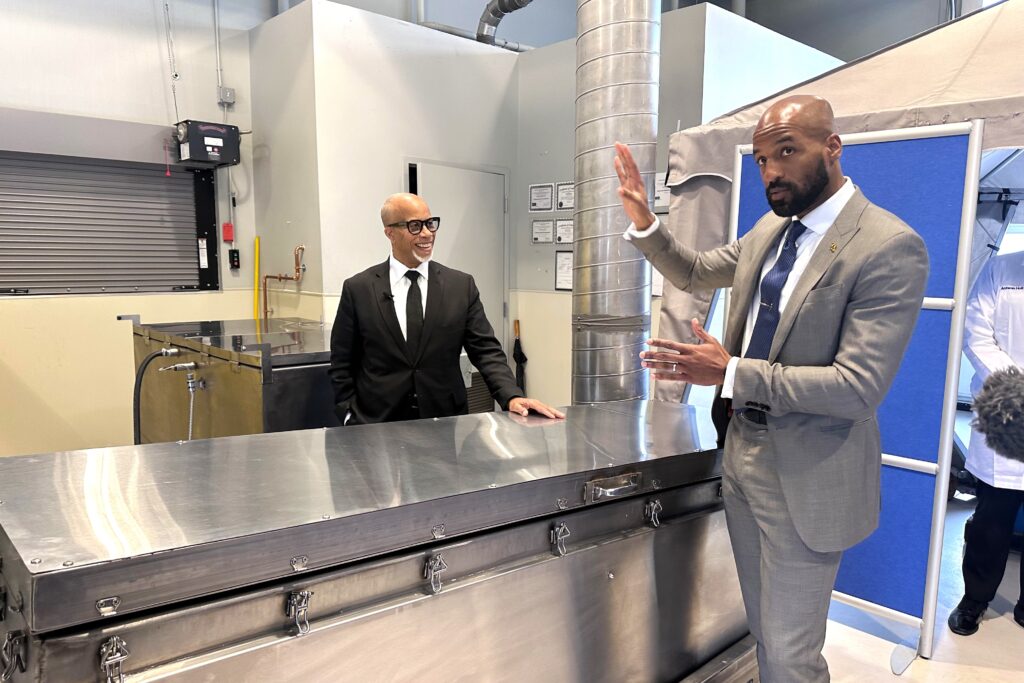
Funeral home director Joseph H. Brown, left, stands Thursday with Baltimore City Councilman Mark Conway over an alkaline hydrolysis system that provides a “water cremation” option. Photo By Danielle J. Brown.
A Baltimore funeral home could be bringing a new meaning to the term “watery grave.”
At the Joseph H. Brown Funeral Home Thursday, officials talked about what they believe is the next trend in “death care options,” a process called alkaline hydrolysis which they described as a sort of “water cremation” alternative to standard fire-based cremation.
“We are looking for more sustainable death care options,” said Joseph Brown, owner of the funeral home where the state’s first water cremation occurred. “Options that are cleaner, greener, kinder and gentler, not only to the environment but to the body as well.”
It’s a new death option in the state. In fact, Brown has the only alkaline hydrolysis system in Maryland, and he’s only performed one water cremation so far.
But he says, the more people know about the process, the more they will choose it for their post-death care as more families look to “greener” funeral options for their loved ones.
And it’s not just families who are concerned about the environmental and health impact of cremation and other funeral practices — lawmakers are involved, too.

During the 2024 General Assembly, lawmakers directed the state’s Office of Cemetery Oversight and the Board of Morticians and Funeral Directors to create regulatory standards for alkaline hydrolysis, along with other alternative burial options. Those regulations have not been finalized yet.
And citizens of North Baltimore have been pushing back against plans by another local funeral home to build a new crematorium, claiming that it will reduce air quality for the community.
That’s one of the reasons why Baltimore City Councilman Mark Conway joined the Thursday tour of Brown’s funeral home — to promote his legislation that would restrict where crematoriums can be built in the city.
“Baltimore has one of the highest asthma rates in the country,” Conway said Thursday. “And as we think about where we do fire cremations and where it is appropriate to do so, we want to be very considerate and very thoughtful about the impact on those communities.”
According to the Cremation Society of North America, a single fire cremation can release about 524 pounds of carbon dioxide into the air, among other health and environmental concerns. Water cremation does not release airborne emissions, greatly reducing the environmental impacts, advocates say.
Alkaline hydrolysis works by submerging a body into 25-40 gallons of water warmed to 140-160 degrees. Potassium hydroxide is then added break down the body.
“What that does is it disassociates the proteins,” Brown explained. “Breaks the proteins down into amino acids, breaks up the amino acids and the bonds that hold them together. That also goes for viruses, bacteria, DNA, anything that’s protein-based.”
After three hours, the fluids are drained into the wastewater system and “what we are left with are skeletal remains,” according to Brown. “Calcium phosphate that we return to the family just like we do with conventional flame cremation.”
Brown admits that it’s not a cheap option for most families yet. He said that water cremation costs about $5,000, due to the chemicals needed to process the body, whereas typical fire-based cremation can cost about $1,700.
“Water cremation is more expensive at this time, but I believe as it begins to scale, that we can be able to bring that price down,” Brown said. “It’s a ‘bougie’ cremation. Soon it will become more of the norm.”

Conway, on the other hand, wanted to highlight the water cremation as an available option for the region, as he is proposing legislation to restrict where standard crematoriums can be built in the city.
“The bill that I introduced will define cremation within the city code and allow it in certain districts and pull it out of certain districts. Specifically, it will pull it out of C2 districts and allowing it by permit in C3, C4 and in open space districts,” he said.
“The idea here is that C2 typically is a site where it is very much in the center of neighborhoods,” Conway said. “They are walkable communities, they are close to neighborhoods, close to homes and otherwise.”
Brown’s funeral home on the West side of Baltimore is in a C2 district and has two incinerators . Conway said he is unsure whether his bill would restrict Brown from continuing fire cremations, or if his practice would get grandfathered in as the only funeral home in the city with an on-site cremation facility.
“Yes, funeral homes need the ability to do fire cremations, but should they do it in every instance? Probably not,” Conway said. “I think that’s what this bill tries to deal with delicately and fairly and that’s what we’re looking forward to addressing.”

